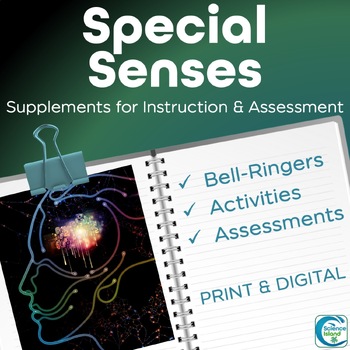Senses Activities, Bell-Ringers, and Assessments - Nervous System Supplements
- Zip
- Google Apps™

What educators are saying
Also included in
- All of Science Island’s Supplements for Anatomy & Physiology in one terrific money-saving BUNDLE! Whether you’re new to teaching A&P or just looking for some new ideas to add to your day-to-day routine, this bundle is sure to make your teacher life a little easier!Here’s what’s included . .Price $139.00Original Price $186.00Save $47.00
- All the resources you need to teach high school Human Anatomy and Physiology! Includes BOTH print and digital paperless resources . . . perfect for in-class instruction, distance learning, 1:1 classrooms, or flipped classrooms!This Anatomy & Physiology Curriculum by Science Island is perfect forPrice $279.00Original Price $524.20Save $245.20
- This chapter bundle includes all the resources you need to teach the Nervous System in high school Anatomy and Physiology in BOTH print and digital formats. Please click the VIEW PREVIEW button above to see more details. SIX RESOURCES INCLUDEDNervous System PowerPoint and NotesOver 75 slides with clPrice $43.00Original Price $54.65Save $11.65
Description
This Special Senses supplement bundle includes 11 inquiry, reinforcement, review, and assessment activities to complete your study of the Special Senses and save you tons of time!
You'll find everything from bellringers to diagrams, a lab, and fun hands-on activities plus all the assessments you'll need for teaching the Senses in Human Anatomy and Physiology.
These activities and assessments are the perfect complements to the Senses PowerPoint and Notes, but they can also be used to reinforce any textbook or other content you're using.
Designed for a high school Human Anatomy and Physiology course, most resources in this chapter are EDITABLE so you can customize them to suit the needs of your students.
* Indicates resources that are included in BOTH print and digital formats. Other resources such as the word wall cards, lab activities, and mini-presentations are designed primarily for in-class learning but can be uploaded to Google Drive or other learning management system if you'd like.
INCLUDES:
- Read First document with contact information, product overview, links to digital resources, teacher’s guide, image and font credits, and terms of use.
- 10 days of "3-a-Day's" bell ringers*. Start class each day with 3 quick review questions!
- Word Parts list and colorful word wall cards.
- Four pages of Nifty Notes. These are fun, graphic notes that really help students engage with the content and retain what they've learned.
- External Eye Anatomy Activity*
- Eye Diagram*
- Ear Diagram and Study Guide*
- Senses Stations Lab
- Instructions for Mini-Presentations
- A Quiz* on the Eye: in two versions to help students stay honest, answer keys included
- A Review Sheet*
- Special Senses Test* with 50 editable questions and Answer Key
Please click on "VIEW PREVIEW" above to see more details and make sure this resource is right for you and your students.
What teachers are saying about my Supplements resources for A&P:
⭐️⭐️⭐️⭐️⭐️ "Loved the variety of resources available here. Will definitely be using some of these again in future years. Straightforward and easy to use." A.B.
⭐️⭐️⭐️⭐️⭐️ "These activities are engaging and add enrichment to the curriculum. The labs are easy to use and increase student understanding in buy-in with the content." J.T.
⭐️⭐️⭐️⭐️⭐️ "I have purchased quite a few TPT resources to use during distance learning and I have to say, this resource is by far the best resource I have purchased. Not only are the activities comprehensive and easy to use, they are creative, engaging, and designed to increase student DOL. Thank you for this amazing product Science Island! I will be using this product for years to come in my classroom." E.W.
⭐️⭐️⭐️⭐️⭐️ "This product is amazing!! This shaves off so much time for lesson planning! Thank you for making my life easier!" S.A.
⭐️⭐️⭐️⭐️⭐️ "Thank you for an engaging and beautifully designed resource." A.D.
Please take a look at the PREVIEW to see more details and make sure this resource is right for you and your students.
You might also like:
The Special Senses PowerPoint and Notes
Nervous System PowerPoint and Notes
Happy Teaching!
Carla Brooks
Science Island








